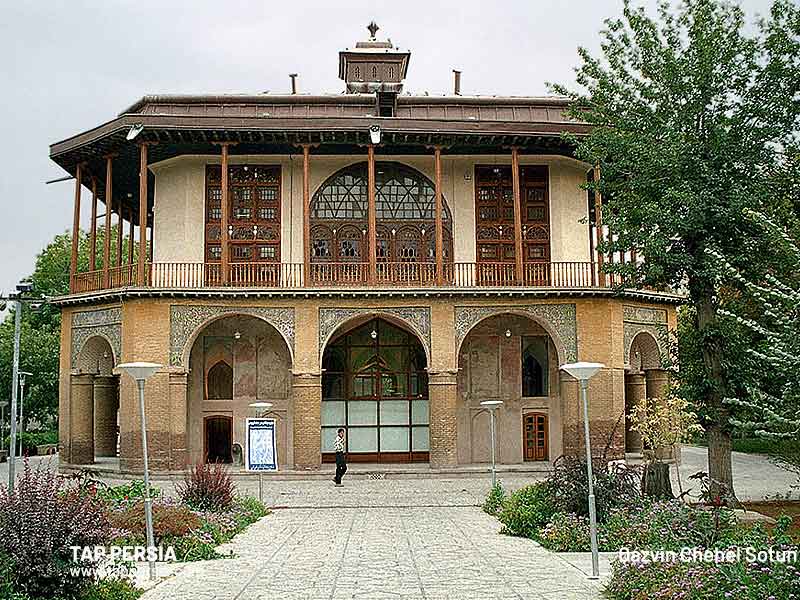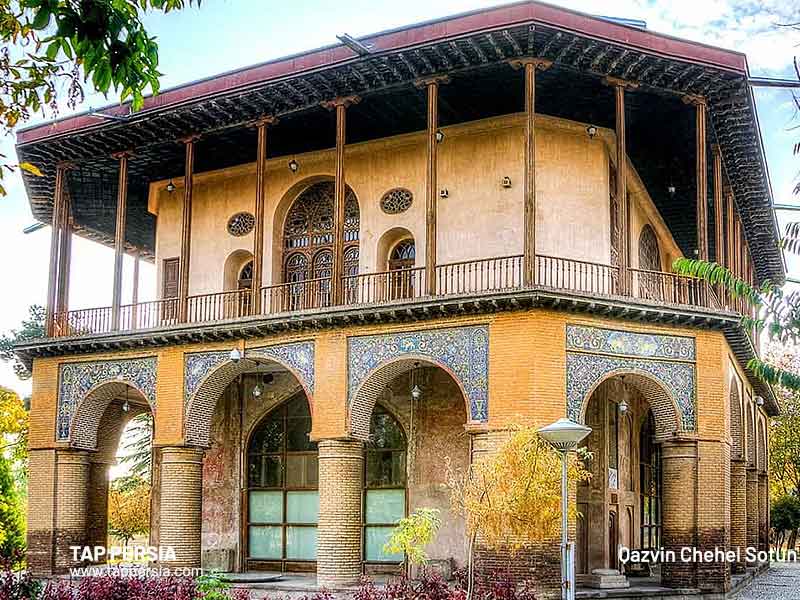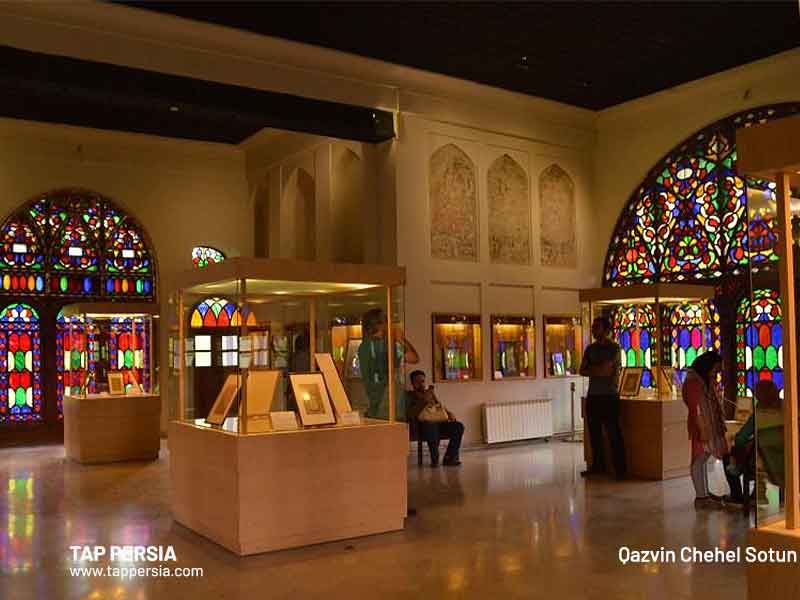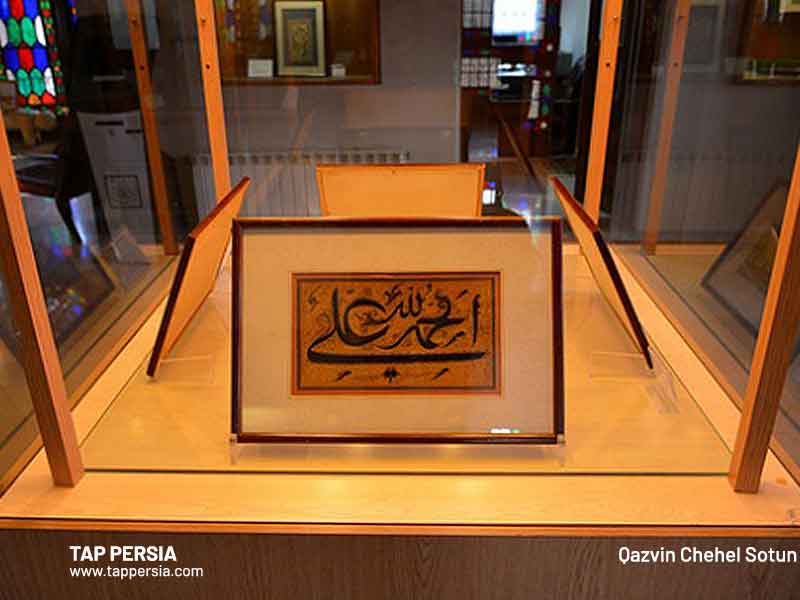One of the significant constructions of the Safavid era and the sole surviving pavilion of Shah Tahmasb’s royal residences from the middle of the 10th century AH is the Qazvin Chehel Sotun house, also known as Kolah Farangi. The wall paintings of this structure, which is around 500 square meters in size and has two stories and is designed in the style of Iranian architecture, are a unique example of Qazvin school artwork. This majestic palace, which was included to Iran’s list of national monuments in 1955, was converted into the Qazvin Calligraphy Museum in 2004, and it is now regarded as one of the city’s most well-known attractions.
Introducing Qazvin’s Chehel Sotun Palace
People frequently go to the Chehel Sotun Palace in Isfahan when searching for that name. Shah Tahmasb, the second ruler of the Safavid dynasty, also commissioned the construction of a historical palace in Qazvin with the same name.The works of several well-known Iranian calligraphers, including Mir Emad Qazvini, Darvish Abdul Majid, Mohammad Hossein Emad Ketab, etc., are shown at this palace, also known as the Kolah Farangi mansion, which has been converted into a calligraphy museum. In 1955, the Qazvin Chehel Sotun Palace was listed as the 389th historical monument in Iran.
History of Qazvin Chehel Sotun Palace

One of the most exquisite and priceless historical structures in Qazvin city, the Forty Seton Palace is a remnant of the Safavid era. Due to Ottoman Turk invasions, the Safavid Shah Tahmasb decided to relocate the capital from Tabriz to Qazvin in 951 AH.
He purchased the Zangi Abad lands from Mirza Sharaf Jahan, one of the nobility of Qazvin city, since he wanted a structure fit for the monarch of Iran. Shah Tahmasb gave the nation’s finest architects the task of creating a square-shaped park and filling it with exquisite homes, halls, porches, and ponds. In honor of the heyday of the Kolah Farangimansion, Mohammad Baqer Saad ol-Saltaneh, the governor of Qazvin, restored it and gave it the name Chehel Sotun. Parts were added to the second level at this time, somewhat altering its exterior and interior.
Sadly, this mansion’s purpose was modified during the Pahlavi era, when it became a governor’s office. 1957 saw the plaster removed, exposing the artwork underneath. They removed these paintings in 1973, causing significant damage to the structure when they were removed.
Qazvin Chehel Sotun Palace was rebuilt and refurbished during the Islamic Revolution, and it was finally rolled around the porches in 1978. They rebuilt its wooden columns with iron beams between the years 1981 and 1982. They also cut tunnels into the base of the columns to drain moisture away from the structure.
In order to keep snow and rain from getting inside the structure, the gabled roof was renovated in 1992. The palace’s purpose has changed recently to become a calligraphy museum, and heating, cooling, and safety equipment have been added.
The architecture of Qazvin Chehel Sotun Palace
The two-story palace of Qazvin Chehel Sotun is roughly 500 square meters in size and is shaped like an octagonal column. This palace’s layout has a cruciform pattern with the outward axis. Shah Tahmasb used the Turkish architectural design to build this home in a much more compact checkerboard pattern, with a hall and a few tiny rooms on each story.
The Qazvin Chehel Sotun Palace’s relationship to the Safavid government palace complex, which is connected to one another through underground tunnels, is one of the intriguing aspects of the building’s design. Originally constructed as an escape route from the palace in the event of an enemy invasion, these subterranean tunnels extended all the way to the outside of the city.
Different parts of Qazvin Chehel Sotun Palace

We will now talk about the different parts of this wonderful mansion:
Entrances
The Qazvin Chehel Sotun mansion’s numerous brick gateways, each of which is embellished with ceramic tiles, floral designs, and traditional Iranian imagery, are among its most attractive features.
First Floor
A wide hall with four rooms on each of its four sides, all from the Safavid era, can be found on the first level. This building has four porches, which were once open to let airflow through them and provide a nice coolness inside. However, currently, they are covered with glass to protect the structure and its embellishments. In addition, the entrance’s slope caused the air to flow directly from the outside to the middle of the building, which improved ventilation.
Ponds were located in the middle, to the north and south of the first floor. The ponds’ water flow helped to cool the air within the structure, and the occupants benefited from their calming sound. Only the southern and central ponds still exist and have been repaired at this time. In order to avoid dampness, the water flow is also stopped. This floor is surrounded by a portico made of brick columns and semicircular arches. Nearly every structure from the Safavid and Qajar eras has beautiful artwork on the walls.
Beautiful Muqarnas on the first floor’s ceiling display the high level of art used in their creation. Originally made of bricks, the mansion’s floor has been covered with clay by the cultural heritage group.
Second Floor
You enter one of the palace’s earring chambers after passing the stairs. You can exit this area and walk into Morteza Hall, a spacious, well-lit hallway. There are four earring chambers around this hall, but only one serves as the link between the lower hall and the upper hall. The earring chambers were not included in the building’s original design and are a product of Qajar-era architecture.
From all four directions, the mansion’s interior is illuminated and colored by its sashes. These sashes’ glasses, which are created in Germany and symbolize the four seasons of spring (green), summer (red), autumn (yellow), and winter (blue) (winter). The beauty of sashes is enhanced with Quranic texts and phrases. This area of the house used to be decorated with paintings, but as of right now, it is merely dark green in hue.
Decorations of Chehel Sotun Palace in Qazvin

The murals on the first floor of the Chehel Sotun Palace in Qazvin are well-known, and the building is not just notable for its architecture and history. The Kolah Farangi mansion’s design and construction are evidence that Safavid Shah Tahmasb loved art. The first floor’s wall murals showcase a superb example of Qazvin School of Painting artwork. These paintings endured significant damage as a result of the building’s shift in usage during the Pahlavi era and were plastered over.
There are only a few paintings surviving from the second floor’s abundance of décor and artwork. This building’s walls are covered with three layers of paintings; the first and second levels are from the Safavid era, while the third layer is from the Qajar era. Paintings during the Safavid era employed watercolors, which resulted in softer colors. However, during the Qajar era, vegetable dyes were used, which resulted in somewhat sharper colors.
The Safavid period miniature paintings on the first level featured gentle curves and twists in the male and female forms. Romantic sceneries were a specialty of the time’s artists. Birds like the redbreast sparrow, duck, pheasant, and others have a role in the wall paintings as well. The birds’ contour and level of detail may be likened to well-known pieces by Reza Abbasi, Shafi Abbasi, and other painters from this era.
Qazvin calligraphy museum
One of Iran’s most comprehensive calligraphy museums is Qazvin Calligraphy Museum, which is housed at Chehel Sotun Palace. The ancient artwork and possessions of the palace are also on display at this museum.The calligraphy works of this Qazvin calligraphy museum are created with different lines such as Naskh, Thuluth, Taliq, Nastaliq and broken Nastaliq and are the art of the great calligraphy masters of Qazvin and Iran.Among these elders, we can mention Mir Imad Qazvini, Emad al-Ketab, Malek Mohammad, Darvish Abdul Majid, Mir Ali Heravi, Malik Deilami, Vesal Shirazi, Zainul Abedin Qazvini, Mirza GholamReza, Mir Hossein Khoshnevisbashi, Khajeh Ekhtiyar and Ahmad Neirizi. It is interesting that the type of writing of these works represents the calligraphy art of the Qazvin school.

Tips for visiting Chehel Sotun Palace in Qazvin
Below are some things that you need to know before visiting this fabulous place: · Visiting hours of Qazvin Chehel Sotun Palace are from 9 to 18:30. The cost of the entrance ticket to visit the palace in 1401 is equivalent to 4000 Tomans.
Qazvin Chehel Sotun Palace is not suitable for the visit of the disabled, the elderly and people with mobility problems, and the long and inappropriate stairs have made it impossible to visit the second floor.




Comment (0)